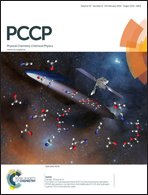The importance of timescale for hydrogen bonding in imidazolium chloride ionic liquids†
Abstract
Hydrogen bond (H-bond) dynamics have been investigated for “hot” 1-ethyl-3-methylimidazolium chloride and “cold” 1-butyl-3-methylimidazolium chloride ionic liquids (IL). While the average number of H-bonds remains constant for a ≈100 °C temperature change we show that the underlying dynamics of the H-bonding changes dramatically. H-bond dynamics are investigated based on distance and angle criteria, and on the H-bond state (zero, single or bifurcated H-bonds). Temperature effects on the cation ring reorientational dynamics are also examined. Angle deformations are found to be more important than bond stretching in determining the lifetime of individual H-bonds, and decay occurs on two time scales related to the magnitude of the deviation from linearity. Rapid angular oscillation of the anion breaks the H-bond (for the first time) and minimal temperature effects indicate that H-bonds are readily reformed even near the melting point. Intermittent H-bonds repeatedly break and reform over a longer timescale, and exhibit very strong temperature effects. In the hot IL H-bonding with ring and alkyl chain H-atoms occurs, ring reorientational dynamics is anisotropic and the corresponding lifetimes are similar to the intermittent H-bond lifetimes. In the cold IL ring H-atoms dominate the H-bonding and intermittent H-bonds last for ≈5 ns, ring reorientation occurs on a much slower timescale. The hot IL favours single H-bonds, but the individual ions often change, while the cold IL favours bifurcated H-bonds with the same co-located ions.


 Please wait while we load your content...
Please wait while we load your content...